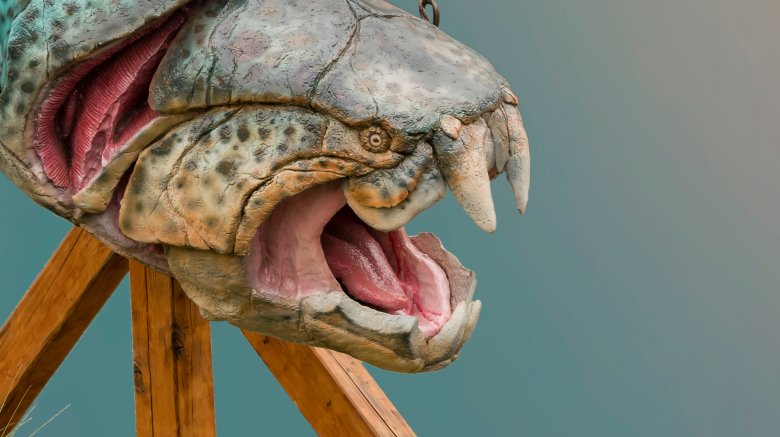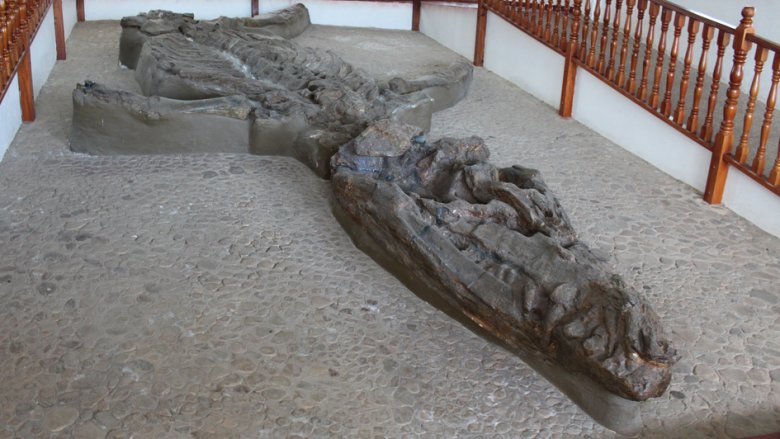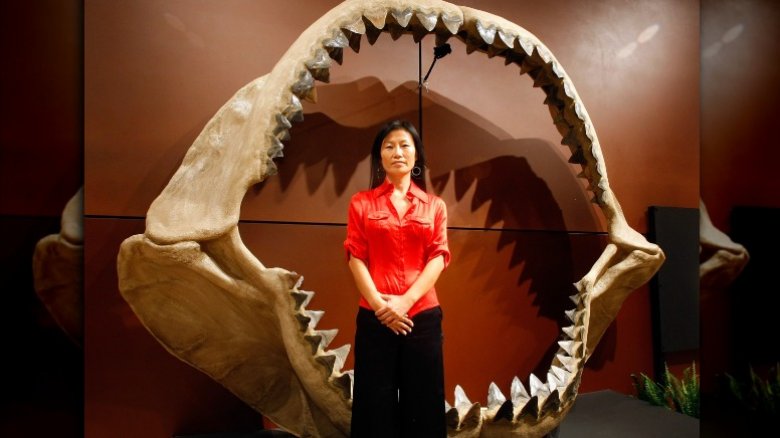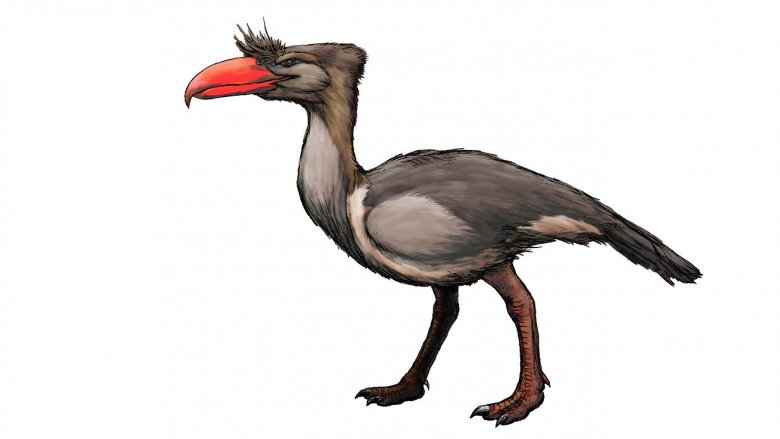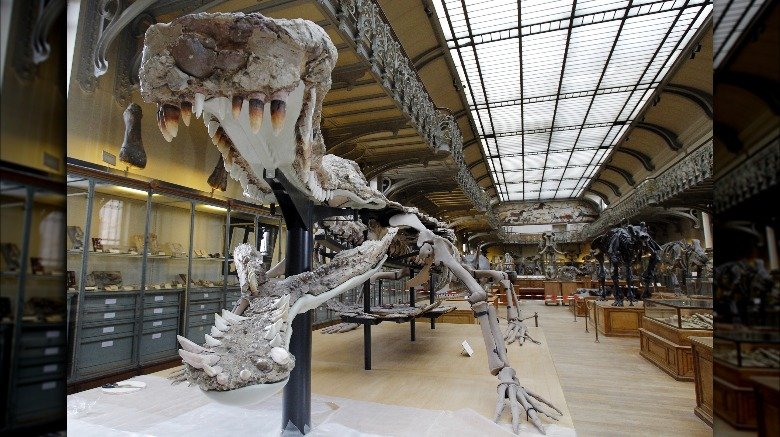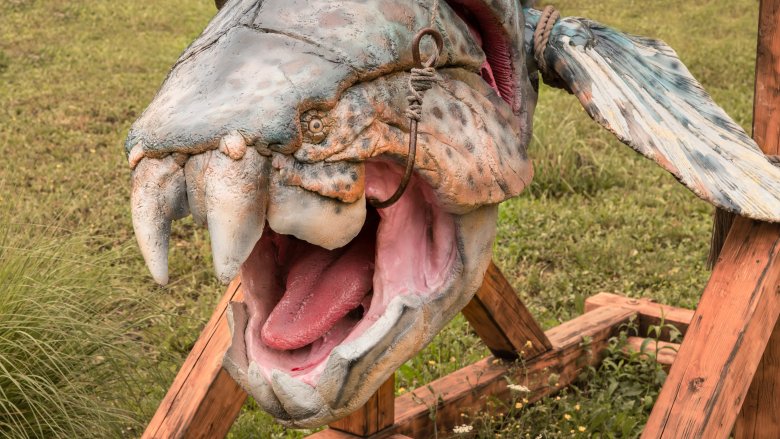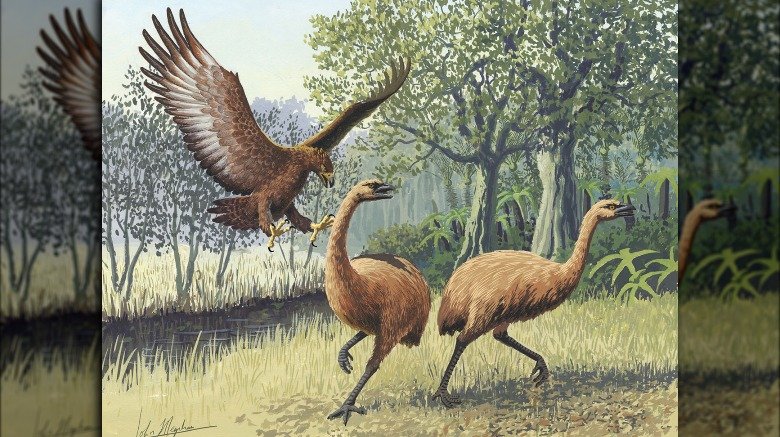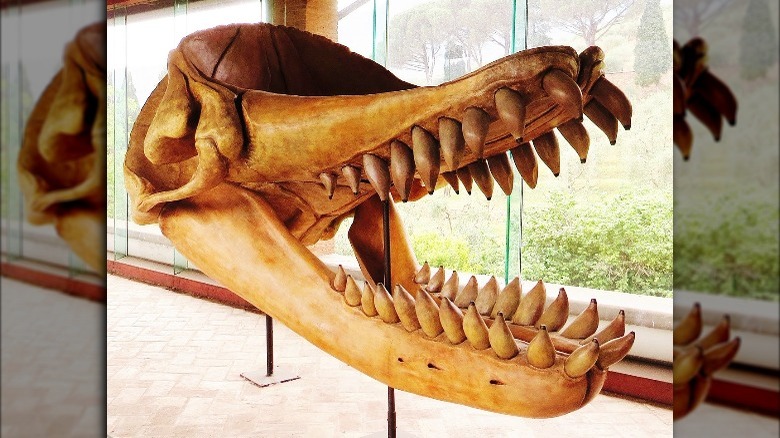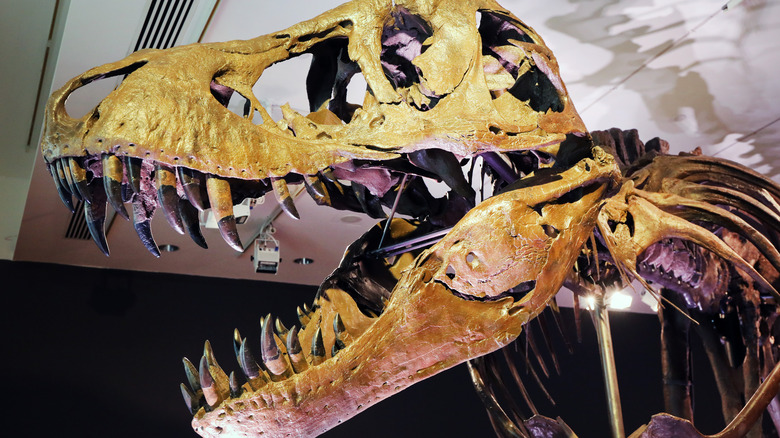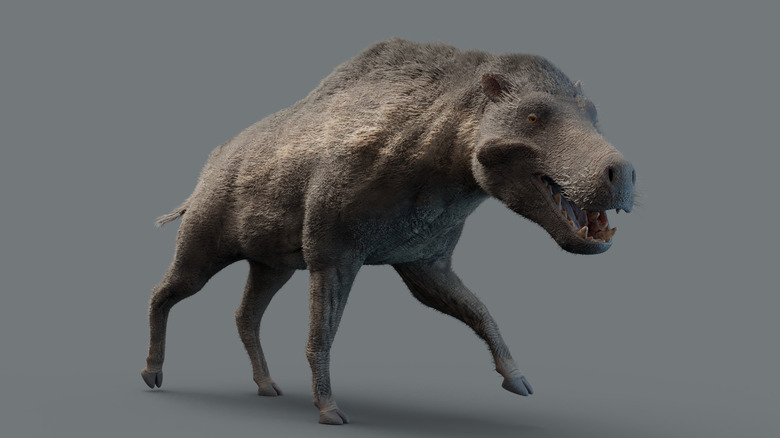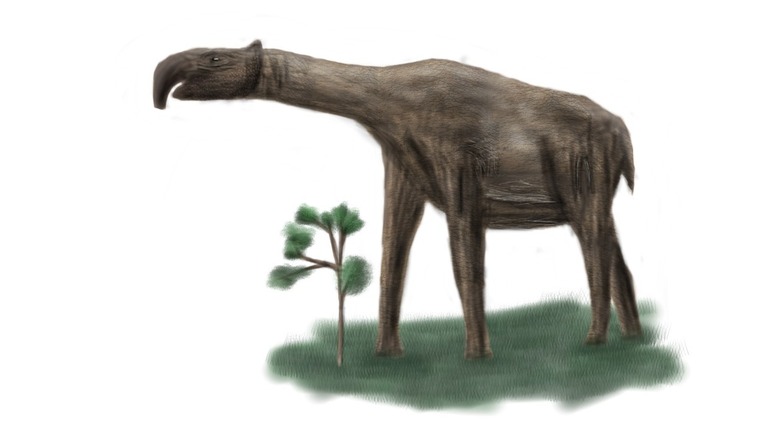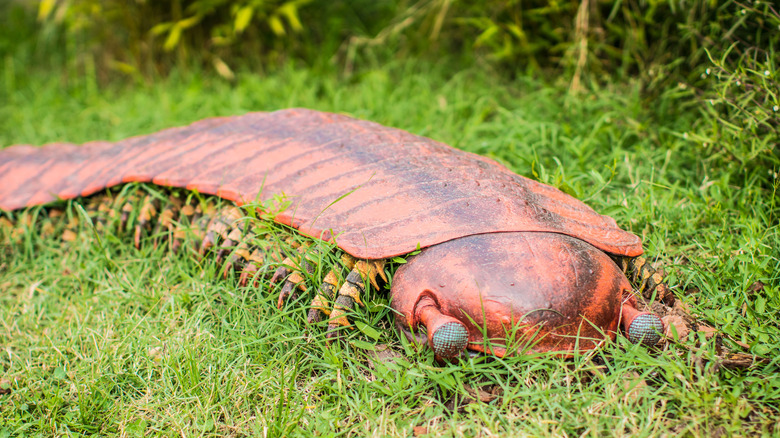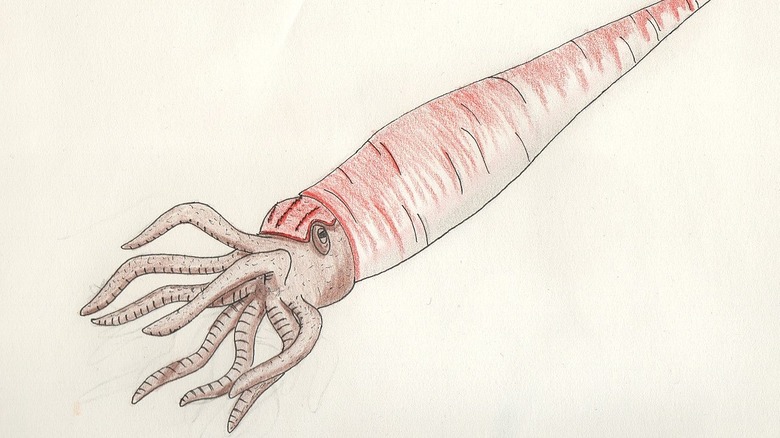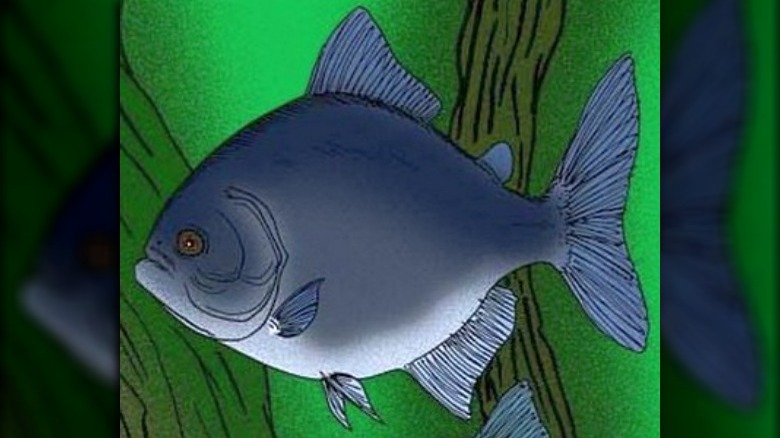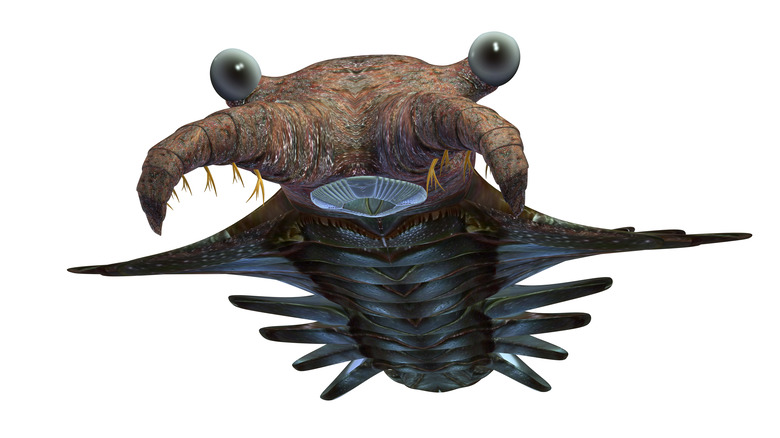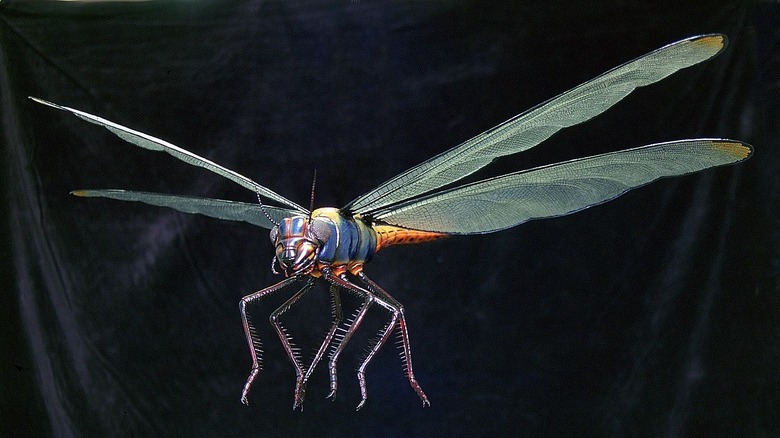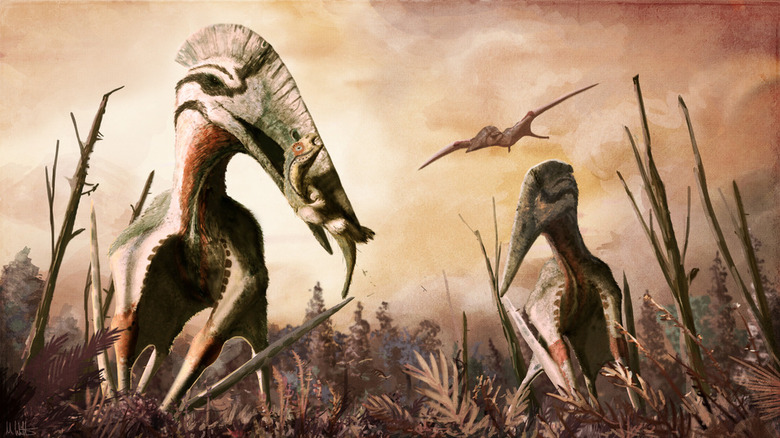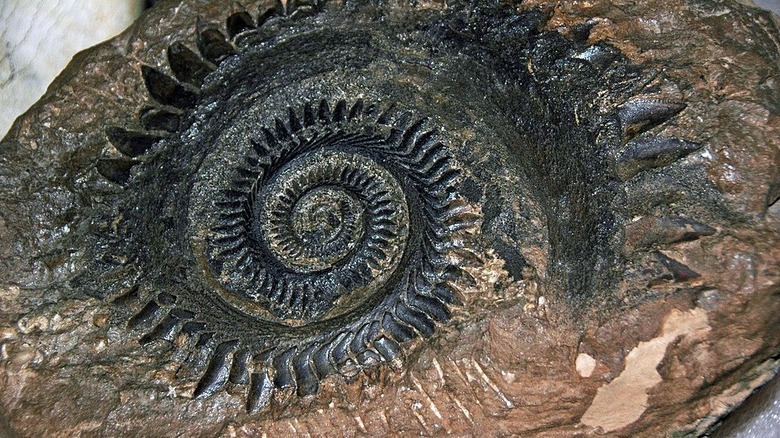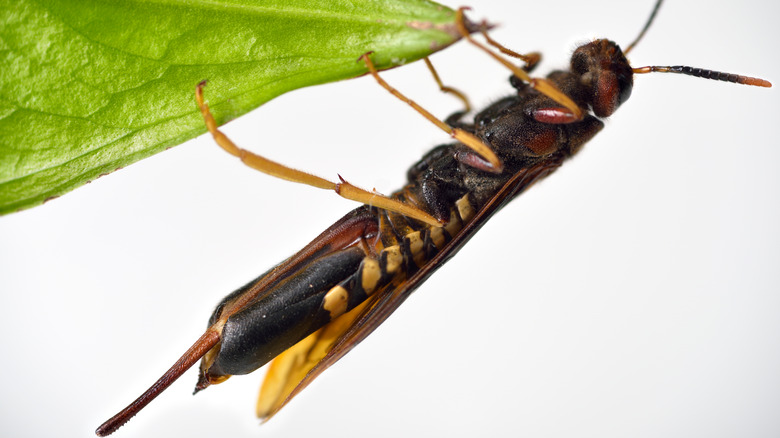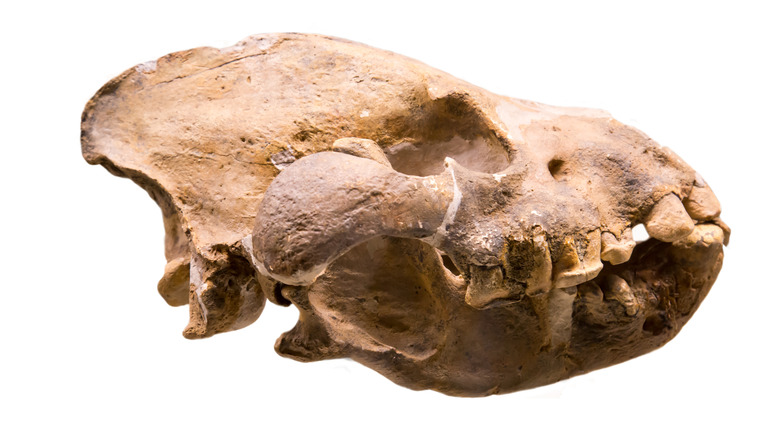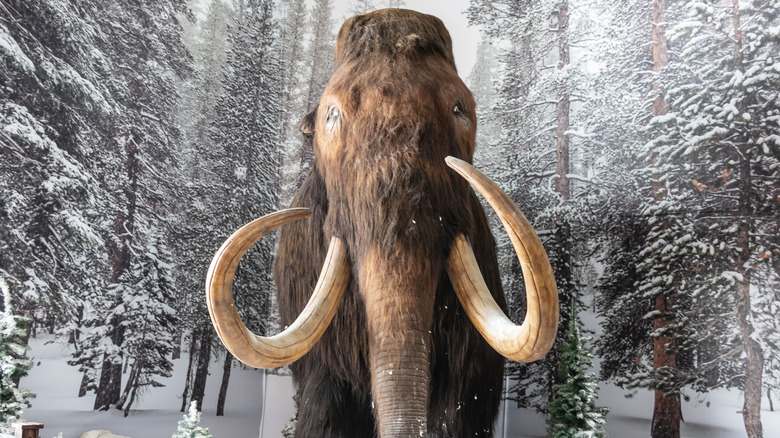Extinct Creatures That Would Wreck The Earth If They Were Alive Today
The rise of human beings from wussy tree-dwelling primate to conquerors of planet Earth was largely due to luck. We evolved during a time when most truly horrifying predators existed only as fossils, which means we could do things like walk around on the ground, swim in the ocean, and live past the age of 19.
Which does sort of make you wonder, what would become of the human race and the modern world we live in if suddenly some higher power just resurrected all of pre-history's most terrifying creatures? Would we still have beach vacations? Camping trips? Ranching? Survival in general?
Thankfully, the era of enormous, terrifying predators is mostly over, with the exception of grizzly bears, crocodiles, and the Discovery Channel. But because it's fun to look back through time and ask ourselves "What if?" let's have a look at some of those horrifying, real-life creatures of bygone eras that would almost certainly wreck the modern world if they somehow managed to make it to the 21st century.
Kronosaurus
If your mom forced you to watch Jaws as an 8-year-old ("It's a classic!") and then you couldn't sleep for days because you were convinced Jaws was living in your waterbed, then you almost certainly don't want to hear about Kronosaurus because Kronosaurus is a million times scarier than a great white shark and would make pretty short work of both you and your waterbed.
According to ThoughtCo, Kronosaurus was named after Kronos, the Greek Titan who ate his own children, so yeah. Kronosaurus was a marine reptile that lived 120 million years ago, measured roughly 33 feet from snout to tail, and weighed maybe 7 to 10 tons. By comparison, the largest-known great white shark is about 20 feet long and weighs at least 2 tons. Kronosaurus' teeth weren't as sharp as a great white's, but what it lacked in slash-worthiness it made up for in brawn and speed. It was a seriously fast hunter and probably killed by crushing and shaking its prey.
So what would it mean for modern humans if this terrifying creature suddenly reappeared in oceans around the world? Well, it could probably eat your 15-foot sailboat, and it would certainly not hesitate to eat a 7-foot surfboard or a 6-foot swimmer. So say goodbye to oceanic recreation unless it's on a really, really big boat, and even then you might want to get your insurance policy in order well in advance of your bon voyage.
Argentavis magnificens
The F-104 Starfighter has a wingspan of just under 22 feet. So did the Argentavis magnificens, but one of those things is not like the other. The F-104 Starfighter is an airplane, and the Argentavis magnificens was a bird. That's right, a bird that was literally the size of a freaking airplane. So if this creature existed today you would probably just not want to go outside, ever.
According to Ameghiniana, Argentavis magnificens lived in Argentina roughly 6 million years ago. It was a vulture, but it didn't eat just carrion. Scientists think it also consumed prey, like large rodents, small armadillos, and camels. Yes, camels. Granted, the camels of 6 million years ago were only the size of large deer, and Argentavis were probably only feeding on young camels but still, daaang. If this thing were alive today it would seriously change the goat farming industry, that's for sure.
But Argentavis magnificens was not actually the largest bird that ever lived (that we know of). That honor belongs to Pelagornis sandersi, which had a whopping 24-foot wingspan. Scientists think Pelagornis sandersi probably preyed on things like fish and squid, so it probably wouldn't go for a person but still, imagine what it would be like to get crapped on by one of those things while you were whale-watching. It might not wreck the world or anything, but it would sure wreck your day.
Gorgonops
If the demogorgon of "Stranger Things" haunts your nightmares, consider this: The gorgonops (Greek for "dreadful face"), which shares a similar sort of name and a similar sort of reputation and at one point actually existed.
According to Prehistoric Wildlife, this thing could reach roughly 10 feet in length, depending on the species. It was not a reptile but it was not a mammal, either — it was a primitive therapsid, which was an ancestor of today's mammals except without being fluffy or cute in any way. It had huge canine teeth like a sabre-toothed cat and was one of Africa's key predators during the Permian.
The gorgonops might have been warm-blooded and was probably fast on its feet, and its enormous canines would have been well-equipped to tear through the thick hides of most of the herbivores that lived at the time, and also your leather jacket, Ultrex coat, or your super wussy paper-thin human skin. So how would this creature change our world if it still lived today? Well, it probably would have eaten you by now.
Titanoboa
Who doesn't love snakes? They're so cuddly and huggable and venomous and too small to constrict you to death and actually eat you or anything, with a few horrifying exceptions. The largest snake alive today is the giant anaconda, which grows to about 17 feet and can weigh around 550 pounds. (Some anacondas have been noted at around 30 feet in length, but let's just bury that little tidbit as deep as it will go, hmm?)
As horrifying as the idea of a 550-pound snake is, it's only about 22 percent as horrifying as a 2,500-pound snake. Now, at 42 feet, titanoboa was only marginally longer than the longest living anaconda, but it was nearly a ton heavier which means it was more like a horrifying, horrifying, horrifying worm than a snake, except for the whole constricting you until you die thing that worms don't tend to do. According to Smithsonian, if you stood next to one of these things it would come up to your waist, at least temporarily because then it would be eating you and you'd no longer be, you know, standing.
So let's imagine what life would be like if this creature were roaming the suburbs. We wouldn't have cats anymore, or dogs, or horses ... or probably circus elephants either. On the flip side, we wouldn't have to worry about bears in our campsites because the titanoboa would eat all the bears.
Megalodon
Kronosaurus was terrifying but there was another sea creature that could have taken Kronosaurus with one fin tied behind its back and that, of course, was megalodon, which you might know from such fake Discovery Channel documentaries as "Megalodon: The Monster Shark Lives." We don't have to tell you all the many ways that megalodon, if it still existed, would wreck the world. It would eat seals and walruses and it would laugh in the face of dolphins and then eat them, and then it would eat boats and lighthouses and airplanes and whatever the hell else it wanted to eat. Also, Discovery Channel would have been telling the truth and therefore would become quality television programming, and that's really getting into some bizarro-world stuff right there.
Megalodon roamed the seas from 23 million years ago to about 2.6 million years ago, and since Kronosaurus lived 100 million years before the earliest evidence of megalodon, we'll sadly never find out who would win in a fight. Odds are it would be megalodon, though. According to Live Science, megalodon might have been 60 feet long or it might have been as much as 80 feet long, though some party-poopers seem to think that the megalodon wasn't actually any bigger than Kronosaurus, which would be boring. Still, a 33-foot shark is 11 feet larger than the largest known great white, so yeah, it could still wreck some stuff.
Terror bird
So imagine if a T. rex had a baby with a chicken and then an ostrich had a baby with one of those ginormous Steller's sea eagles and then the two babies grew up and met each other on Tinder and then their offspring decided to turn the entire world and all its creatures into a Las Vegas buffet. That was Phorusrhacidae, which are much more accurately known as "terror birds." According to the BBC, these flightless birds were basically just feathered, beaked velociraptors only without the charm and good looks. The terror bird became South America's top predator and reigned for nearly 60 million years, finally disappearing from the fossil record around the same time as megalodon.
One of the largest of these nightmarish creatures was Titanis, which was nearly 10 feet tall, had a top speed of around 43 mph (similar to an ostrich), and could snap the leg of a cow with its enormous feet and could also peck your head off. Literally. So if these things still roamed the Earth, well, there would be a ton of cows with broken legs and lots of humans missing their heads. In the plus column, most employers would be totally fine with telecommuting because no one would want to leave their house, ever.
SuperCroc
Crocodiles are one of the few creatures that actually eat human beings. We may think wolves and tigers and lions are scary, man-eating beasts but when was the last time you heard about someone actually getting eaten by one of those? The saltwater crocodile is the largest reptile on earth — it can grow to be 23 feet long and can weigh more than a ton. Thanks, Nature, that's big enough. No, really.
Well at one point, Nature evidently disagreed and decided to make a much, much bigger crocodile because a 1-ton, 23-foot killing machine is evidently just not impressive enough. Enter Sarcosuchus, the world's largest known crocodile. According to ThoughtCo, Sarcosuchus, also known as "SuperCroc" (because of course SuperCroc) could reach lengths of 40 feet and might have weighed 10 times as much as its pathetic little saltwater cousin.
Now, scientists do think that Sarcosuchus probably ate fish, which means it probably would not have really been a huge threat to humans but still, you probably would want to avoid building a theme park right next to the swamp where it spends most of its time. And as far as fishing is concerned, well, the industry might not have the same kind of draw if these things were competing with anglers for all the rainbow trout in the local river.
Gigantopithecus
Bigfoot is so elusive he evidently doesn't poop and disintegrates when he dies, and occasionally puts bear DNA in his hair samples just to confuse everyone who wastes their time and money looking for him. And if you don't find him, you can buy plenty of T-shirts and coffee mugs and fridge magnets that will at least let your friends know you gave it your best shot.
So what would the Bigfoot industry look like today if Gigantopithecus still roamed the Earth? According to National Geographic, this huge primate was 10 feet tall and weighed more than half a ton. It thrived in the warm tropical forests of China for around 6 to 9 million years, then the last Pleistocene ice age rolled around and Gigantopithecus died out because as the climate changed and forests gave way to savannas, there wasn't enough food to maintain a large population of calorie-hungry beasts of gigantic proportions.
Fortunately, Gigantopithecus did the smart thing — it caught a boat to southern Oregon and set up camp in the woods where it learned to emulate the haunting yet melodic call of the reality television producer. Just kidding. It did no such thing and neither did any other primate, except for humans attending the Oregon Shakespeare festival.
Dunkleosteus
The good news is that a lot of these insanely terrifying predators lived in the ocean. So as long as you moved to Kansas or something, you'd only have to worry about decapitation by pecking, being swallowed by a snake with the girth of a large tree, baseball-sized bird poops, and random other land-based terrors. Meanwhile, the ocean could stay mercifully on the other side of the prairie. And a good thing, too, because Dunkleosteus lived in the ocean and Dunkleosteus made piranhas look like goldfish.
Dunkleosteus predates the megalodon and it even predates dinosaurs — it lived 360 million years ago, was nearly 20 feet long, and was basically the Kraken minus the tentacles plus the armor of a tank. According to Earth Touch, Dunkleosteus' head was covered with thick, bony plates, which ended in super-sharp fangs that were made from the same material as the bony plates. They were designed to scrape together when the fish opened and closed its jaws, so being approached by one of these things was the equivalent of being approached by a dude in a helmet and plate armor who is meticulously and deliberately sharpening two large machetes, only underwater.
So in a world where Dunkleosteus still lived, swimming, boating, wading, or looking at the ocean without a sense of foreboding would all be pretty much off the table.
Haast's Eagle
It's at least some small comfort that most of these creatures never shared the Earth with human beings — they vanished long before human beings took those tentative first steps out of Africa. And a good thing, too, because if all these terrifying creatures had been roaming the African landscape, the ancestors of human beings would have never come down from the trees.
Don't relax just yet, though, because at least one perfectly-capable-of-eating-humans creature did share the world with people, and it wasn't really that long ago, either. The Haast's eagle lived in New Zealand and was still flying around being terrifying as recently as 500 or 600 years ago. According to New Zealand Birds Online, Haast's eagle had a wingspan of nearly 10 feet and an arrangement of feet and claws that rivaled a modern tiger. It probably ate Moa, which were large, flightless birds that became extinct around the same time as the Haast's eagle did.
Here's where it gets extra-super-scary — native New Zealanders have an oral tradition that includes descriptions of Haast's eagles actually attacking human children, so we don't have to even imagine all the ways this predator might have been dangerous to people because it was actually, literally dangerous to people.
Short-faced bear
Bear spray costs like $40 a bottle, and people will pay that much for the stuff because bears are super terrifying and will actually kill and eat you if you happen to be in the wrong place at the wrong time. But hey, at least grizzly bears are typically only between 5 and 8 feet tall when standing upright, so you might actually have a chance if you decide to engage in hand-to-paw combat with one. (Haha no.)
If you ever met a short-faced bear, though, forget it. According to Bears of the World, the short-faced bear was 12 feet tall when standing upright and could weigh up to a ton. An adult was capable of killing a bison, which is like five or ten times heavier than you are and also way, way faster than you, too.
And like the Haast's eagle, the short-faced bear shared its territory with humans, so it was almost certainly a major existential threat to the early people of North America. It died out roughly 12,000 years ago, though, which is unfortunate from a species diversity perspective but pretty danged fortunate from the camping industry's perspective because if short-faced bears still roamed North America they'd have to make tents out of steel and that would be super impractical for most backpackers.
Neanderthals
No matter how hard we try, human beings still haven't been able to snuff out racism. So what would life on planet Earth be like if we also had species-ism to deal with? What if Neanderthals still roamed the Earth. Would we be ignoring their job applications, calling the cops on them for barbecuing in the park, and generally making life for them uncomfortable and dangerous?
Well, if Homo sapiens can't learn to get along with each other, it seems pretty unlikely that they could learn to get along with other types of humans. On the other hand, perhaps the presence of similar but fundamentally different types of humans would be humbling. Maybe we wouldn't have grown to think of ourselves as a completely unique and superior species, and maybe as a result of that we'd be much better caretakers of our planet.
According to Real Clear Science, Neanderthals disappeared 30,000 years ago, so we won't ever know what our relationship with our close cousins was actually like — which makes it hard to speculate about what it might be like if Neanderthals still lived. It is a pretty safe bet, though, that Neanderthals would wreck life as we know it ... but let's just pretend that it wouldn't be in a bad way.
Megalania
One of the great things about the modern world is that you can mostly avoid becoming a meat snack for some other animal, unless your dog has an unfortunate change of opinion about your place on the food chain. But modern humans aren't that far removed from our meat snack ancestors, who hadn't yet arrived at the apex position in the hierarchy of the world's predators.
Megalania looks an awful lot like something that roamed the Jurassic with Stegosaurus and Gargoyleosaurus and whatever the heck a Juravenator was, but it was actually kind of terrifyingly modern. Like, "maybe this thing still exists somewhere in the far corners of the Australian outback" modern. According to ThoughtCo, this monstrous creature lived during the Pleistocene up until around 40,000 years ago in what is now Australia, which isn't actually super surprising, since roughly 90% of the things that can kill you today also live in Australia.
No one knows if Megalania was 12 feet in length or as long as 25 feet, but it was definitely somewhere in the range of "oh my god!" and "holy flesh-hungry demon spawn!" It was between 500 pounds (still 350 pounds more than the similar if diminutive Komodo dragon) and 4,000 pounds, which is pretty close to the weight of a male hippopotamus. And based on what we know about komodo dragons, which sometimes kill children, it's likely that it hunted early Australians, so yikes.
Spinosaurus
Quick, name the biggest, baddest dinosaur to ever walk the earth. Unless you are a dinosaur nerd, your answer was almost certainly "the T-Rex." But this dinosaur makes T-Rex look about as fierce as the plastic "Toy Story" T-Rex. The biggest, baddest dinosaur to ever walk the Earth was Spinosaurus aegyptiacus, which was 50 feet long. Compare that to T-Rex, which was a mere 40 feet long, though, to be fair, both dinos were equally rotund, weighing in at around 7 tons.
According to Reuters, besides its hearty appetite, Spinosaurus didn't really have a whole lot in common with its smaller, Hollywood-darling cousin. It was a quadruped, for a start, and is, in fact, the only carnivorous dinosaur we know of that walked on four legs instead of two. It was also semi-aquatic and preferred to eat fish. But not like a nice salmon sashimi or a shrimp cocktail or something in reasonably small portions, no — Spinosaurus ate sharks and crocodiles and, as Reuters likes to say, "car-size fish." So, first you will need to absorb the idea that car-sized fish were a thing before then contemplating what it would be like if Spinosaurus fell through a portal and started eating literally everything in the sea.
Footnote: some dinosaurs were bigger than Spinosaurus aegyptiacus, but they weren't predators.
Smilodon
Don't let the cheerful name fool you, Smilodon probably only smiled while it was tearing its prey to bits, and then probably only because it had something stuck in its teeth. Otherwise known as the saber-toothed tiger, Smilodon was not, in fact, a tiger or really even closely related to one. Instead, it was a member of a subfamily called Machairodontinae, which were the forerunners of modern felines.
Contrary to popular belief, the "smile" part of "smilodon" doesn't refer to the animal's cheerful disposition. The name actually comes from the Greek "smile," meaning "two-edged knife" or "scalpel," and "odontus," meaning "tooth." Those scalpel teeth were an inch shy of a foot long and hung over Smilodon's bottom lip like the world's most dorky and yet terrifying overbite.
Smilodons looked kind of like someone stuffed a walrus inside of a rhinoceros and then stapled a couple of lion pelts to the outside, except they were also agile enough to take down large prey like bison and probably even juvenile Mastodons. According to the BBC, early humans were unfortunate enough to share habitat with Smilodons, which weren't just scary because of the tooth thing about also because the biggest Smilodons were roughly chest-high on an average-sized adult human male and weighed over 800 pounds, so eek. Scientists don't agree on whether they chased or ambushed their prey, but quite honestly, who cares because neither alternative would really make you feel great about going for a stroll on the back 40.
Andrewsarchus
This animal wasn't exactly a wolf. In fact, it wasn't exactly even remotely like a wolf, judging by its freakishly large head and weird, stripey butt, though the stripey butt is just one artist's idea about what Andrewsarchus might have looked like. The truth is that no one actually knows, because the only evidence that this huge predator even existed is a single skull someone found in Mongolia in 1923. Still, a skull does tell you a few things — Andrewarchus had a three-foot-long head, could have been the largest terrestrial mammalian predator that ever lived, and strongly resembled the Rodents of Unusual Size that thwarted Wesley and Buttercup's escape through the Fire Swamp.
According to ThoughtCo, Andrewsarchus lived roughly 35 to 45 million years ago during the Eocene epoch, and it may have weighed up to 2 tons, which is about the mass of two draft horses. This is all just based on that giant head, though, and it's actually possible that Andrewsarchus had a disproportionately large head propped atop a laughably small body, which would make it somewhat less impressive. But hey, it's really the teeth and jaws that matter most when evaluating the Earth-wrecking potential of a large predator, so it's unlikely you'd be laughing at Andrewsarchus' stupid-looking body while it was busy separating your disproportionately small head from your disproportionately small shoulders.
Livyatan
Just when you thought predatory mammals couldn't get any bigger, let's leave land and venture back into the seas, because the seas aren't already scary enough with their 50-foot waves and vast expanses of nothing but water and Megalodons and Kronosauruses and whatever other thing is ready to eat you as soon as you fall off your boat. Anyway, once upon a time, a predatory whale known as Livyatan (Hebrew for "Leviathan," after the Old Testament sea monster) hobnobbed with Megalodon or probably just engaged with Megalodon in the occasional epic struggle for domination of the seas. (Put that on Shark Week, Discovery.)
If Livyatan lived today, seafood restaurants wouldn't exist because fishermen would only be fishing in shallow ponds at least a couple of miles inland. According to ThoughtCo, this enormous killer whale was a full 39 tons larger than the largest recorded member of the killer whale species we all know, love, and force into entertainment careers at Sea World. At 50 tons, Livyatan was the largest known predatory mammal and also had the largest teeth of any animal known to live anywhere on the planet, ever — imagine what those 14-inch long things could do to your rubber dinghy if you met one of these whales while out for a low-budget pleasure cruise. Actually, never mind, the teeth probably wouldn't damage your dinghy at all because Livyatan would just swallow it and you up whole.
T-Rex
No list of extinct creatures that would wreck the Earth if they were alive today would be complete without the T-Rex, which was really bad at doing push-ups but made up for all of that with jaws that had a bite force of around 6 tons, enough to make scientists wonder why this famous predator didn't break its own skull when it bit down on its prey. (A recent study concluded that the T-Rex's skull was so rigid that it could resist all the bite force exerted by its powerful jaw muscles.)
Anyway, T-Rex may not have been the largest known dinosaur predator to ever walk the Earth, but it doesn't really matter because if turned loose upon the modern world, it might easily decide humans are on the menu. (And really, why wouldn't it?) You've seen "Jurassic Park" — no Jeep, restroom stall, or rotunda would be enough to separate a hungry T-Rex from its prey, and it's kind of doubtful the average three-bedroom, two-bathroom home in the suburbs would offer a whole lot of protection, either. In fact, according to National Geographic, this 40-foot long predator had 60 8-inch-long serrated teeth and was big and bad enough that it would probably eat other T-Rexes in tough times.
Dinohyus
Unless you're a pig farmer, you probably imagine modern bacon-making machines as fat, lazy, mud pit-dwellers, and as far away from aggressive as you can get without being Elijah Wood. That's probably because you've never encountered wild boars, which are terrifying and sometimes attack humans. If you've ever been menaced by one of these creatures, you can maybe start to imagine what Dinohyus — which means "terrible pig" — must have been like. (As an aside, the obviously cooler name "Dinohyus" has been replaced by "Daeodon" because some other, more boring scientist evidently picked that name first.)
According to the Carnegie Museum of Natural History, Dinohyus was the size of a buffalo. Also, its skull was nearly three feet long. It may have been a forager but was probably also a scavenger. That means that like modern pigs, Dinohyus was an omnivore. Now, if you aren't a pig farmer or have never seen a movie about the mafia, it may surprise you to hear that pigs eat meat, but they do.
Science isn't sure if Dinoyus was an actual ancestor of modern pigs or if it was just uncannily pig-like. Either way, if these enormous beasts occupied the modern world and one of them decided to mow down your tomato garden, chicken coup, or band-new Tesla, you'd just have to let it.
Argentinosaurus
Most of the extinct animals that still terrify us today were predators, but let's not forget that even docile, plant-loving animals can be destructive and could have world-wrecking potential if they suddenly decided to embark on a mass migration through a time portal.
One animal we probably don't want coming through a portal is Argentinosaurus, the largest known land animal ever. Sure, it would be really cool to see one of these things in a zoo or something, but think about the potential destruction that could be levied by an animal that is 115 feet long and weighs 150,000 pounds. No one has really done any analysis of how much food an animal that size requires, but a research assistant at the University of Bristol at least had an educated guess — Argentinosaurus may have eaten around 1,875 pounds of plant matter each day, which translates into around 880 pounds of poop.
So let's imagine that just one of these dinosaurs ended up in a cornfield. Now let's imagine a whole herd of them ended up in a cornfield. It wouldn't take long for the farmer's cornfield to disappear, and there wouldn't be much anyone could do to stop it short of asking the military to drop a couple of bombs on the offenders. On the flip side, the farmer would have plenty of fertilizer available for next year's crop, so there's at least that.
Pulmonoscorpius
Except for the occasional weirdo, almost no one loves a scorpion. According to Medscape, there are roughly 1.2 million scorpion stings across the world every year, and 3,250 deaths. So even if you are the occasional weirdo who thinks scorpions are cool, you are also keenly aware of how dangerous they can be (unless you are an especially dumb weirdo).
The good news is that modern scorpions aren't huge. Well, they are huge — the giant forest scorpion can reach 9 inches in length — but compared to Pulmonoscorpius, the giant forest scorpion would be more appropriately named the beensy-weensy forest scorpion. According to Prehistoric Wildlife, Pulmonoscorpius was a whopping 28 inches long, which is roughly the length of a small raccoon, only flatter.
If Pulmonoscorpius existed today, it's hard to predict exactly what sort of havoc it would wreak on the modern world. Scientists don't really know how venomous it was, so we can't really say if it would be scrabbling around the city streets indiscriminately toppling human beings or if it would mostly just be living in people's garages or under their beds. But just based on size alone and on the fact that all scorpions have venom, it's probably safe to say that its mere presence would be enough to make humans build their homes out of concrete and spend their days in a fetal position, rocking back and forth and muttering incomprehensible words about the eight-legged monsters that are out to get them.
Linxia giant rhino
The biggest animal to ever walk the Earth was a dinosaur, obviously, but prehistoric mammals reached some seemingly impossible sizes, too. According to CNN, paleontologists recently discovered the fossilized remains of a giant rhino in the Linxia Basin of northwestern China. This previously unknown species has since been dubbed the largest known land mammal.
The Linxia giant rhino measured 23 feet tall at the top of its head and was 26 feet long from snout to tailtip. Just to put that into perspective, a medium-size elephant is only about half that tall, so if you stacked two elephants on top of each other you'd have a couple of really angry elephants, but you'd also have a stack of animal flesh that was roughly the height of a Linxia giant rhino. You'd also have to put another stack of two elephants behind the first stack of elephants in order to achieve the total length of a Linxia giant rhino, and you'd also need a couple of extra elephants standing by in order to achieve the total weight of a Linxia giant rhino (24 tons).
Now, given that modern rhinos have a reputation for being ill-tempered and sometimes like to charge people in stripey safari jeeps, we might be able to assume that Linxia giant rhinos would have a similar dislike of humans, although they might have been big enough that they'd think of us merely as irritating insect-like things that could be stomped out of mind. Either way, Earth-wreckers for sure.
Arthropleura
According to SWNS Digital, a 2019 poll conducted by OnePoll on behalf of Zevo (a company that sells bug-killing products), discovered that around 64% of us are afraid of bugs. There might have been a teensy bit of potential for bias in that study, but never mind. Just based on that statistic alone, Arthropleura would wreck civilization simply because its presence would keep more than half of adult humans permanently locked inside their homes, daring only to emerge when fully armed with flame throwers or backpack chemical sprayers full of RAID.
Arthropleura is believed to be the largest insect that ever lived, reports the University of Cambridge. The largest-ever fossil of Arthropleura was discovered in a piece of fossilized sandstone in Northumberland, England, in 2018, and even though this creature lived 326 million years ago there are almost certainly people in Northumberland who are thinking of moving to Iceland now.
Arthropleura was a millipede. It had lots of legs, and it was also nearly 9 feet long. Cambridge helpfully points out that this means it was roughly "as big as a car," just in case you hadn't completely formed the visual yet.
Notably, none of Arthropleura's existing fossils include the animal's head, so no one knows if it was just a very large but typical millipede or if it had the head of a dragon or something, but either way it's a good thing for bug fearers everywhere that these things no longer crawl the Earth.
Simbakubwa kutokaafrika
A giant predatory dinosaur is a terrifying thing to imagine, but mammalian predators are scary on a whole different level, maybe because they're just a little too familiar, just a little too real. Animals like the T-Rex and Spinosaurus are so unlike anything in human experience that they might as well be dragons.
If you were to meet Simbakubwa kutokaafrika on the savanna late at night, well, let's just say it would eat you long before you managed to figure out how to pronounce its name, which means "big lion from Africa" in Swahili (via CBS). According to a 2019 paper published in the Journal of Vertebrate Paleontology, Simbakubwa kutokaafrika was a Hyainailourine hyaenodont, which were some of the largest mammalian carnivores known to science. Despite the name, members of the hyaenodont weren't related to modern hyenas, and didn't look much like them either. In fact to a modern human they'd probably look somewhat familiar — a little bit like lions and a little bit like bears (via Discover), but much, much bigger than both. In fact, researchers think Simbakubwa kutokaafrika may have weighed around 3,300 pounds, roughly three times as much as a polar bear, which according to The Guinness Book of World Records is the largest terrestrial carnivore that exists today.
Cameroceras
Stories of sea serpents have been told for centuries, even as recently as 1930 when four fishermen in New South Wales, Australia (via Australian Geographic) claimed to have been pursued by a 80-foot-long thing like a giant eel. Modern biologists and even many early 20th century scientists who were around to hear the stories think these were most likely sightings of the tentacles of giant squid. According to Smithsonian, the largest squid ever discovered (in modern times) was around 43 feet long and probably weighed about a ton.
Like the giant squid, Cameroceras was a cephalopod, and it did look a bit squid-like from the front. The rest of it, though, looked more like one of those weird horns they blow in the Swiss Alps and/or on Ricola commercials from the 1990s. According to a University of Barcelona paper, it's hard to say how big Cameroceras really was since only small fragments of it have actually been discovered. But some sources, including Springer Geology, say these things might have grown up to 33 feet long, big enough to wreck scuba diving as we know it. Cameroceras was an apex predator, but because its long, weird shell kept it from being super maneuverable, it was probably an ambush hunter. So modern scuba divers would have been like, "What is this alphorn at the bottom of the sea? Let's just swim down and have a — ."
Megapiranha
Because piranhas aren't scary enough already, how about a "mega piranha." Why not? Prehistory did love to up the ante on our most terrifying creatures with their own super-sized versions. Hopefully, Future History doesn't get any ideas from Prehistory, although the way things are going, the only creatures that will still be around for Future History to muck with are cockroaches and house mice.
Anyway, yes there was once a piranha large enough to be dubbed "megapiranha." According to ThoughtCo, it lived 10 million years ago, was roughly 5 feet long, and weighed between 20 and 25 pounds. Like the piranha known and loved today, it lurked in murky South American rivers, where it mostly preyed on fish because there weren't any humans around to accidentally fall into the water while for some reason canoeing around in megapiranha-infested waters.
Let's be fair, though, there's only one way these things could possibly wreck the Earth if they still existed. Supervillains would put them in swimming pools, attach laser beams to their heads, and then confess to all of their supervillain crimes while dangling Austin Powers over their giant, snapping jaws. This wouldn't completely destroy civilization or anything, but it would at least make supervillains more effective. So who knows, perhaps the megapirhana could indirectly lead to the destruction of the moon or the emptying of the ocean or whatever it is supervillains like to do with their time.
Anomalocaris
Let's go way, way back now, more than half a billion years to the Cambrian Epoch. During this period of time, there were no big predators chasing helpless creatures through forests because life was confined to the ocean (via Live Science).
The Cambrian's apex predator was an animal called Anomalocaris. Granted, this predator wasn't big by our standards — only about 3 feet in length — but it was huge compared to everything else in the ocean. According to National Geographic, Anomalocaris was armed with some crazy weapons, like undulating flaps that gave it speed and spiked arms that it could use to grab its prey. And its eyes were huge and on stalks, possibly so it could spot its prey using near-360 degree vision and possibly also to make it extra-super creepy.
How would Anomalocaris wreck the Earth if it was alive today? Well, given that no other creature in the sea is similarly armed or has vision quite as keen, it would probably have a very unfair advantage over any fish used to being chased by mere sharks or fishing nets. And let's not forget that it wouldn't be fun to be grabbed by something with spiked arms, whether you're a fish or some poor guy out for a swim in Anomalocaris-infested waters.
Maiasaura
Nothing really runs around in massive herds anymore. Before colonial times, tens of millions of bison (via Fish and Wildlife Service) roamed the grasslands of the Midwest in massive herds, but no more. That is an awful thing for the buffalo, but there are plenty of people living on the Great Plains who probably wouldn't like to see the great herds return. Regardless of how you feel about civilization, it would be pretty hard for humans to carry on doing the things they do if suburbia was at risk of random trampling by massive herds of bison.
And massive herds of bison don't even begin to compare to what a herd of Maiasaura would have been like. According to ThoughtCo, these duck-billed dinosaurs grew to be about 30 feet long, weighed about 5 tons (compared to half to 1 ton and 10 to 12 feet for an adult bison, via National Wildlife Federation), and lived in massive herds. In fact it's likely that their herds may have numbered in the thousands, so imagine that crashing through your backyard fence on a Sunday morning. Now let's bring back Maiasaura's primary predator — Troodon — and imagine what it would be like if the Maiasauras weren't just after your tomatoes but fleeing en masse for their lives. If these animals still roamed the Earth, let's just say there wouldn't be a whole lot of room left for human neighborhoods.
Meganeuropsis
As far as insects go, there are a few that get a pass even from insect-hating humans. Butterflies, of course. Bees, at least for the non-allergic. And dragonflies. Watching a dragonfly alight on your car's antenna or the end of your fishing pole can be a delightful experience.
Of course, if the dragonfly that alighted on the end of your fishing pole was Meganeuropsis permiana, then the fishing pole would probably snap in two and you would drown because you lept off the boat while fully clothed.
If Meganeuropsis permiana existed today, it probably wouldn't be a man eater, but it definitely could have wrecked some serious fishing poles. According to a study published in the Journal of Experimental Biology, Meganeuropsis permiana had a wingspan of more than 2 feet and a body that weighed around a pound. The University of Nebraska-Lincoln says that's about the size of a crow.
Unlike butterflies, dragonflies don't just flit from flower to flower looking pretty and collecting pollen. They are predators, and something the size of Meganeuropsis permian probably ate large bugs, though Harvard Magazine says it may have also eaten small amphibians. And small human children. Just kidding. There were no small human children 248 million years ago, but who knows what Meganeuropsis permiana might do if it was unleashed on the world today. Probably a lot more than just breaking fishing poles.
Propleopus oscillans
Who doesn't love a kangaroo wearing boxing gloves, or, if you're more of a naturalist, a kangaroo leaping gracefully across the Australian Outback?
If your knowledge of kangaroos transcends those stereotypical images, you're probably aware that the boxing gloves should go on the kangaroo's hind feet because those are the parts that really pack a punch. In fact Popular Science says there is 759 pounds of force in the kick of a red kangaroo, and never mind that the claws on the kangaroo's foot could also potentially eviscerate you (via Slate).
Anyway, here's a fun fact — Propleopus oscillans, also called the giant rat kangaroo, lived during the Pleistocene, weighed up to 150 pounds, and probably ate meat, as per PBS, maybe even people meat, since there's a good chance that it was still around when humans arrived in Australia (via the Australian Museum). Now granted, some modern kangaroos do get that big, but they're vegetarians, so if you don't try to catch them and put boxing gloves on them you're probably safe.
To be fair, Propleopus oscillans was a rat kangaroo, not an actual kangaroo. According to PBS, its closest living relative is the musky rat kangaroo, which weighs only 18 pounds. And the musky rat kangaroo doesn't hop, so it probably didn't kick with as much force as a red kangaroo. If you were imagining a predatory kangaroo hopping towards you with its mouth open, you can at least get rid of that terrifying image.
Hatzegopteryx
Every person reading this thinks of Dracula when they see the word "Transylvania," because ever since Vlad the Impaler decided to punish everyone who was ever mean to him by putting their still-breathing bodies on pointy things, Transylvania has been synonymous with bloodthirsty creatures. And now, also add bloodthirsty giant pterosaurs to that list. This is really quite fitting when you consider that pterosaurs are reminiscent of huge, terrifying bats, and Dracula did like to turn into a bat occasionally.
According to Earth Archives, Hatzegopteryx lived in Transylvania during the late Cretaceous and was one of the largest pterosaurs currently known to science. Not big like a condor or big like an albatross ... it was big like a giraffe and had a 40-foot wingspan. Its skull alone was 10 feet long.
Hatzegopteryx could fly, but scientists think it was probably more stork-like in its habits — and not "delivers babies" stork-like, either, more like "delivers a deadly blow with its giant, giant jaw" stork-like. It preferred to eat things much smaller, which is unsurprising since literally everything that lived in Transylvania at the time was much smaller than it. It's unclear how it would have behaved in a world full of humans, but let's just say if it was still around there probably would have never been a Vlad the Impaler to inspire the tale of Dracula because it would have eaten him.
Helicoprion
Some weird-looking things have swum in the sea. Many of them still swim in the sea. Others had crazy adaptations that may or may not have been too crazy to support their long-term existence.
You've probably seen pictures of Helicoprion, though you may not have seen the right pictures. In fact according to the authors of a study published in Biology Letters, there have been at least a dozen different theories about what Helicoprion looked like, specifically where on its body the "whorl" was supposed to go. The whorl, by the way, is the large wheel of razor-sharp teeth that through the years have been placed on Helicoprion's nose, back, lower lip, and sticking out of its mouth like a tongue. It's only been in the last decade or so that scientists have finally settled on where the whorl probably goes: tucked away inside its mouth like the blade of a rotary saw, which makes sense because it had pretty much the same purpose as a rotary saw.
According to Scientific American, Helicoprion probably eviscerated its prey with that bottom row of teeth, which acted like a slicing device when the beast closed its mouth.
Contrary to what most people assume, Helicoprion wasn't a shark — it was a chimaera, which is only distantly related to sharks. And it might not wreck the world if it was alive today, but it would certainly wreck the limbs of many, many surfers.
Giant horntail wood wasp
In 2015, researchers discovered the fossilized remains of an insect they dubbed Ypresiosirex orthosemos (via The Canadian Entomologist). Which sounds innocent enough, but this particular insect was not innocent. First of all, it was a wasp, and second of all, it was around 2 3/4 inches long, reports Pique Magazine, so think murder hornet plus another inch (according to Popular Mechanics, murder hornets are typically between 1.5 and 2 inches).
That sounds very scary, but from a human perspective one of these creatures would only be terrifying while flying straight towards you, and for no other reason than because giant wasps flying straight towards you are generally terrifying regardless of the circumstances. This particular wasp was a giant horntail wood wasp, which actually lacks a stinger so couldn't inflict anything but psychological damage on you if it decided to land on you. And to be fair, there are species of horntail wood wasp living today that are only marginally smaller than Ypresiosirex orthosemos (via Pique).
Still, horntail wood wasps have the capacity for a lot of destruction, and it's possible this 53- million-year-old wasp could bring down an entire forest if it were to reappear today. Modern wood wasps like the sirex woodwasp (via Invasive Species Center) bore holes in trees and can become invasive, killing even healthy trees that don't have the natural ability to fend them off. There's no reason to think Ypresiosirex orthosemos wouldn't be an equally big problem.
Giant short-faced hyena
Unless you watched "The Lion King" as a very small child, you probably don't think hyenas are that terrifying. After all, they kind of just slink around making that ridiculous sound, stealing meat from lions that usually just look annoyed. But the image is kind of deceptive. Hyenas can be pretty menacing, though maybe not quite as menacing as their extinct relative, the giant short-faced hyena known as Pachycrocuta brevirostris. According to a study published in Quaternary Science Reviews, this was the largest hyena to ever live and "perfectly embodied the distinctive bone-cracking adaptations of this mammal family." Yikes.
Pachycrocuta brevirostris lived during the Pleistocene and may have even coexisted with early humans, according to Live Science, though probably not for long given the whole "bone-cracking" thing. It weighed about 250 pounds (via Quarternary International), which according to PBS is roughly the size of a small female lion and about 60 pounds more than the largest spotted hyena (via National Geographic).
Despite its size, some scientists believe that Pachycrocuta brevirostris didn't have the bite strength to be a hunter and was probably more likely to be a scavenger. If that's true, the lions it stole from almost certainly experienced some very different emotions than just feeling kind of annoyed.
Giant sea scorpion
So let's say the world was occupied by giant land scorpions. It's probably safe to say that a large number of us would move to the ocean, where people would live in floating cities and eventually evolve into fish people. Except that oh no, there was also a giant sea scorpion, so evidently, nowhere is safe.
As Nature details, Jaekelopterus rhenaniae had claws that were roughly 18 inches long, which were attached to a body that was probably 8 feet long. It was likely an ambush predator, which means it would kind of just hang out and wait until it saw a foot and then it would rip the foot and everything it was attached to into tiny little bits because it preferred to eat finger food. Or, more accurately, toe food.
Jaekelopterus rhenaniae lived 400 million years ago, reports Nature, and happily there isn't any evidence that it's still lurking in some murky corner of the world. Also, despite the name "sea scorpion," it probably lived in rivers and lakes, so you can go back to your plan to live in a floating city and eventually evolve into a mermaid, just as long as you also stay out of fresh water. Just watch out for the eurypterids (via Yale University), which were giant sea scorpions that actually did live in the ocean and also grew to be around 8 feet long. You can't really win.
Yersinia pestis
When thinking about extinct creatures with the potential for widespread destruction, T-rex in "Jurassic Park" or Discovery Channel's megalodon come to mind. The creatures we should really be worried about, though, are the ones you can't see.
Bacteria are some of the most vicious creatures on the planet, capable of a kind of widespread destruction and devastation that even T-rex would never cause — because T-rex actually had the capacity for eventually feeling full.
According to a study published by Proceedings of the National Academy of Sciences, the Black Death was caused by Yersinia pestis, a bacteria that can still be found living in the fleas that infest critters all over the world. This includes the Norway rats that live in your tool shed and that cute little chipmunk you gave a potato chip to while you were camping last summer.
The strain that caused the Black Death between 1347 and 1351 is now extinct, though, and no one can really say what would happen if it got resurrected. Most people in the developed world aren't exposed to a lot of plague-carrying fleas, and the authors of a study in Antimicrobial Agents and Chemotherapy say Black Death is also treatable with antibiotics, so it's possible it wouldn't cause much harm in the developed world. In the less developed parts of the world, though, it could be devastating.
The flu
No one can really agree on whether or not a virus is alive. Viruses contain genetic material, and their sole purpose is reproducing and spreading — and those are two qualities that all living creatures share. On the other hand, viruses don't have metabolism, and they don't reproduce independently, so they don't meet most definitions of life (via Science News). For the purposes of this discussion, however, let's just say that they count as "creatures." That way people can ponder what would happen if some of the extinct ones were still around today.
The 1918 flu killed around 50 million people (via the CDC), and they weren't just the sick and elderly. Young people were actually more susceptible to this specific strain of influenza than most middle-aged people.
Fortunately, the virus that caused the 1918 flu is extinct. In fact, according to the BBC, flu viruses go extinct all the time. Every flu virus up until about 120 years ago is no longer circulating in human populations or anywhere else (that scientists know of). And that's great, because if the 1918 flu did come back, it's pretty easy to guess what would happen. People would refuse the vaccine, hospitals would be overrun, and a lot of people would die. On the other hand, it's also possible that the fact that the 1918 flu was especially deadly for young people might cause a sudden change in perspective.
The mammoth
Scientists are already toying with the idea of bringing back the mammoth. Some people even argue that bringing the mammoth back might somehow slow down carbon emissions and resurrect ancient ecosystems (via Statesman). If that sounds a little far-fetched to you, you're not the only one who feels that way. And even if it's true, there are some very good questions about what kind of harm it would do to efforts to save other species if our conservation dollars were spent on resurrecting species that have been gone for thousands of years.
In a study published in the journal Nature Ecology & Evolution, researchers argued that de-extincting species could result in a net biodiversity loss, mostly because de-extinction would be so expensive that it would leach money from efforts to save animals that still exist but are on the brink of extinction. So if the mammoth existed today — if it were literally brought back from extinction — it would wreck other species' chances of survival and possibly even wreck ecosystems. Some scientists like Kent Redford, quoted in U.S. News and World Report, even think certain de-extincted species could end up becoming invasive. That's a very real return to existence that's worth a good, long ponder.
